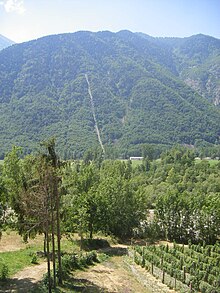Cascarolo bianco
The grape has a long history in the region and was noted in 1606 by Giovanni Battista Croce, vineyard owner and official jeweler to Charles Emmanuel I, Duke of Savoy, as growing in the hills around Torino and producing wine of high esteem.
It was once thought that Cascarolo bianco was the same variety as the Hungarian wine grape Fehér Gohér (also known as Augster Weisser) but DNA profiling in the early 21st century determined that the two grapes are unrelated.
[1] Ampelographers believe that the name Cascarolo is derived from the Italian cascolare, meaning "to fall", which could be a reference to the susceptibility of the variety to the viticultural hazard of coulure which causes unfertilized grape flowers to develop into poorly formed berries that fall off the vine.
[1] Cascarolo bianco is a very old grape variety that has been growing in the Piedmont wine region of northwest Italy for several centuries.
In his 1887 handbook on ampelography, German ampelographer Hermann Goethe speculated that Cascarolo bianco was the same variety as the Hungarian wine grape Fehér Gohér (also known as Augster Weisser) but today DNA evidence has shown that the two grapes are unrelated.

